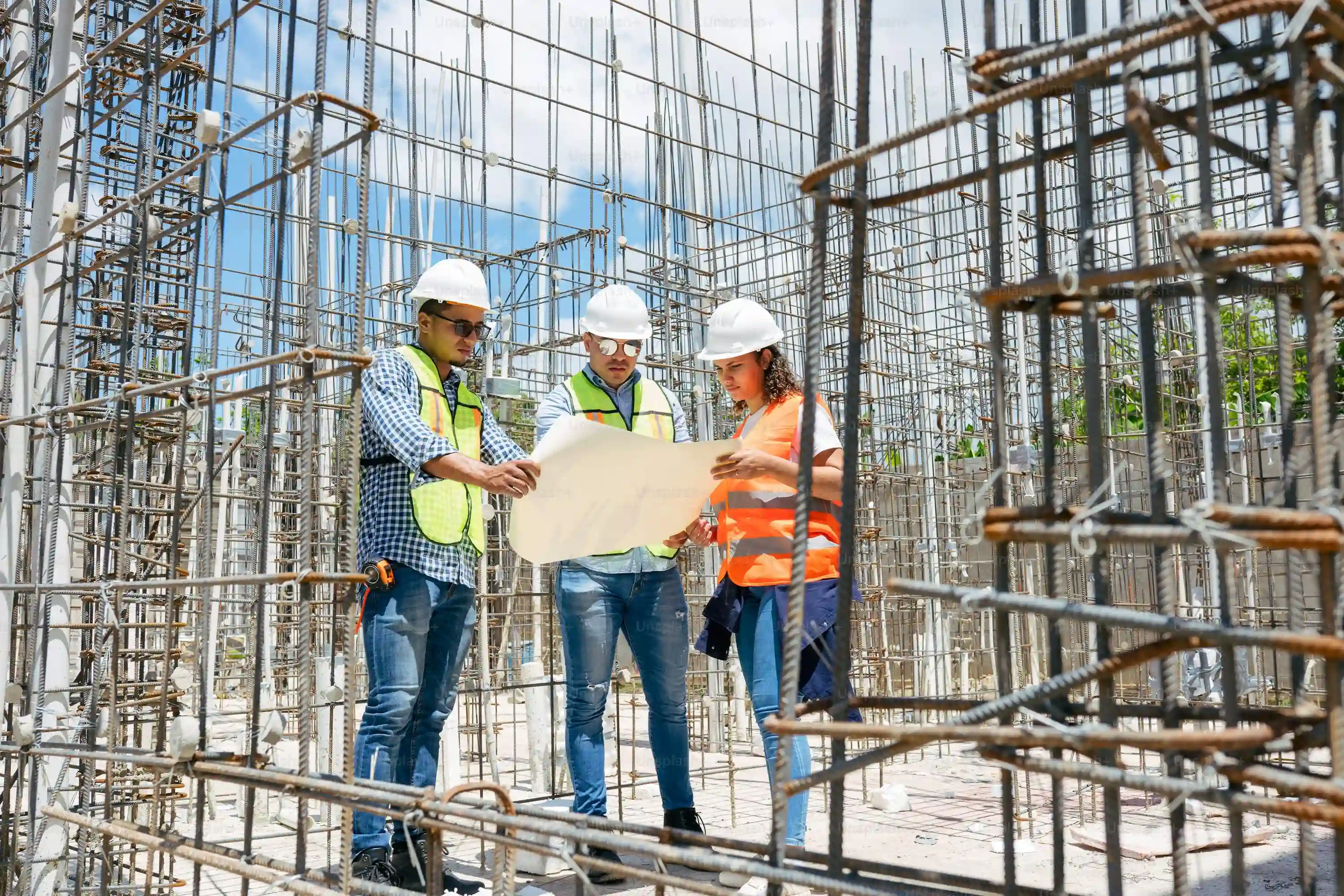5 Ways to Apply Construction Project OHS for Zero Accident
23 October 2025

Construction project OHS (Occupational Health and Safety) plays a crucial role in maintaining safety and productivity in high-risk work environments. Every construction company must understand OHS standards and implementation methods to ensure the project runs safely, efficiently, and without accidents.
So, how can it be applied effectively? Let’s find out below.
What Is OHS in Construction Projects?
In practice, implementing construction project OHS goes beyond using personal protective equipment (PPE). It covers the entire safety management system on-site. Below are the main OHS components that must be applied to every construction project:
1. Workplace Safety
The safety aspect focuses on preventing workplace accidents. This includes identifying potential hazards, providing PPE, and conducting training on the use of heavy equipment.
2. Occupational Health
Occupational health emphasizes preventing illnesses caused by work conditions such as dust exposure, extreme heat, or high physical workload. Regular health check-ups and the availability of medical facilities at the project site are essential components.
Read Also: 9 Workplace Accident Prevention Efforts Often Ignored by Companies
3. Work Environment
The environmental aspect ensures that project activities do not cause negative impacts on the surroundings. Waste management, noise and air pollution control, and proper site organization are all part of this aspect.
4. Risk Management and Site Supervision
Risk management is the foundation of implementing construction project OHS. Regular supervision, safety audits, and incident report evaluations are carried out to ensure that every procedure is properly followed.
OHS Standards and Regulations in Construction Projects?
The implementation of OHS in construction projects is clearly regulated by Law No. 1 of 1970 on Work Safety and Minister of Public Works and Housing Regulation (Permen PUPR) No. 10 of 2021 concerning the Construction Safety Management System.
Berikut penjelasan isi dan penerapan dari regulasi tersebut:
1. Law No. 1 of 1970 on Work Safety
This law serves as the main foundation for implementing occupational safety across the construction sector. Its primary goal is to protect workers from potential workplace hazards and ensure a safe work environment.
It regulates:
-
Company obligations to provide proper PPE.
-
Regular inspections of tools, environments, and work facilities.
-
Mandatory safety training for all project workers.
-
Accident reporting requirements to allow for legal follow-up.
2. Permen PUPR No. 10 of 2021 on Construction Safety Management Systems
This regulation provides specific guidance on applying OHS in the construction industry. It ensures that each project operates under measurable, risk-based supervision.
Key points include:
-
The requirement to integrate OHS aspects into every stage—from planning to implementation.
-
Appointment of OHS officers and routine safety reporting by contractors or service providers.
-
Occupational health management, including periodic medical check-ups for workers.
-
Sanctions for companies that violate safety standards or fail to conduct proper field supervision.
5 Effective Ways to Implement OHS in Construction Projects?
Implementing construction project OHS effectively requires consistent planning, supervision, and evaluation. The goal is not only to prevent accidents but also to build a sustainable safety culture throughout the project.
Here’s how to apply it:
1. Identify Hazards and Assess Risks
Start by identifying potential hazards during the planning phase and measuring risk levels for targeted control. The process includes:
-
Mapping high-risk activities, areas, tools, and materials.
-
Identifying hazards (mechanical, electrical, height-related, chemical, ergonomic).
-
Assessing likelihood and impact (risk matrix).
-
Setting controls: elimination, substitution, engineering, administrative, PPE.
-
Documenting HIRARC (Hazard Identification, Risk Assessment, and Risk Control) and communicating it to all teams.
2. Conduct Regular Training and Socialization
OHS competence requires continuous learning and reinforcement to maintain discipline on-site. Steps include:
-
Develop OHS training curriculum according to job roles (construction helpers, foremen, technicians).
-
Conduct OHS induction before workers enter the site.
-
Hold short daily toolbox meetings.
-
Train workers on emergency response and PPE/equipment use.
-
Evaluate training outcomes and repeat weak areas as needed.
Read Also:7 Warehouse Security SOPs to Prevent Theft & Boost Productivity
3. Perform Routine OHS Supervision and Audits
Standards are only effective if monitored and evaluated consistently. Apply this control cycle:
-
Use daily/weekly inspection checklists.
-
Record nonconformities and set corrective priorities.
-
Follow up with corrective actions within deadlines.
-
Conduct regular internal audits to assess SOP compliance.
-
Report findings and trends to project management for systemic improvement.
4. Provide Complete PPE and Emergency Facilities
Worker protection must be readily available and easy to access to reduce risks. Steps include:
-
Specify PPE per task (helmets, vests, gloves, safety shoes, eye/ear protection).
-
Distribute, inspect, and replace damaged PPE.
-
Provide first aid kits, evacuation routes, fire extinguishers, and assembly points.
-
Install clear safety signs and labels.
-
Conduct regular emergency drills.
5. Evaluate and Report Incidents
Every incident serves as a learning opportunity to prevent recurrence. Build a simple yet thorough reporting process:
-
Require reporting of near misses, unsafe acts, and work accidents.
-
Secure the site, provide first aid, and stop work if necessary.
-
Investigate the root cause.
-
Develop corrective and preventive actions and communicate them to the team.
-
Review improvement effectiveness in the next OHS meeting.
Risks of Not Implementing OHS in Construction Projects?
Without proper OHS implementation, on-site activities can pose serious risks to workers and company operations. Here are the main risks:
1. Workplace Accident Risks
Failure to comply with OHS standards can lead to accidents such as:
-
Falls from heights
-
Being struck by heavy materials
-
Electrical shocks
-
Exposure to hazardous chemicals
-
Extreme fatigue from long working hours
Such incidents not only endanger individuals but also delay overall project progress.
2. Impacts on Productivity and Project Costs
Projects that neglect construction safety are prone to delays due to high incident rates.
Each accident causes downtime, additional medical expenses, and potential fines from authorities, ultimately disrupting efficiency and project timelines.
3. Reputational and Trust Damage
Beyond financial loss, neglecting OHS reduces a company’s reputation and client trust. Contractors frequently involved in workplace accidents will find it difficult to secure future projects.
4. Case Study: Real Impact of OHS Negligence
A common example in construction is when workers fall from scaffolding due to not wearing proper PPE.
Such incidents can lead to project shutdowns, lawsuits, and even loss of operating licenses.
OHS Implementation Solutions Through Professional Outsourcing Partners
Construction project OHS can be implemented more effectively through partnerships with outsourcing companies that follow standardized safety systems.
Through such collaboration, companies gain access to skilled labor and assurance of regulatory and administrative compliance.
As a professional manpower provider, SOS supplies trained and certified workers who understand safety procedures, proper PPE use, and safe work practices on-site.
Advantages of partnering with outsourcing companies like SOS:
-
Workers are knowledgeable in national OHS standards and safety procedures.
-
HR administration, contracts, and reporting are managed in compliance with labor laws.
-
Supervision and performance evaluation systems are integrated and transparent.
Examples of manpower available through this service include construction helpers, cleaning crews, project security personnel, and OHS officers ready to be deployed across various project sites according to company needs.
Read Also: Must-Know! Office Security SOP to Keep Assets & Employees Safe
Ensure Your Construction Project Is Safe and Efficient with SOS Outsourcing Services
As a professional outsourcing manpower provider, SOS is committed to supporting the success of construction projects through consistent implementation of construction project OHS.
Each deployed worker is equipped with safety training and an understanding of safe work procedures, ensuring productive and compliant performance on-site.
Here’s what you’ll get:
-
Certified workers familiar with industry-standard OHS practices.
-
Structured field supervision and administrative management systems.
-
Efficient project operations without compromising safety and legal compliance.
Contact SOS today to find the safest, most efficient, and reliable manpower solutions for your construction project.



